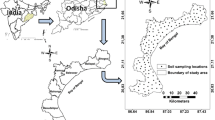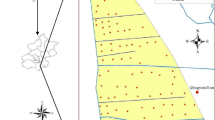Abstract
The effect of rainfall, evaporation, and aridity on salt accumulation in the soil, on a national scale, is not straightforward, and other factors such as geology, position in the landscape, and previous climatic conditions should be considered. Good decisions for the management of salt-affected soils on a national scale require good information, derived from raw data. Such data must be generated with specific goals in mind, and it must be stored properly in a format that is easy to access and process. Like any basic resource, the data environment must be managed meticulously. In this study although data verification was previously done on most samples, much effort was devoted to data cleaning. Of the more than 40,000 original data points, only 22,404 data points were used due to the stringent cleaning protocol. A forward selection stepwise regression was used to simplify the various models. In a stepwise regression, variables are added or removed from a regression model one at a time, with the goal of obtaining a model that contains only significant predictors, but does not exclude any useful variables. The accuracy with which EC, ESP, and pHwater were predicted with stepwise multiple linear regression relationships on a national scale is surprising, considering that the various models included all “outlier” values. The R 2 statistic indicated that the models as fitted explained the variability in EC and ESP much better for the low rainfall class (<550mm annual rainfall), than for the high rainfall class (>550mm annual rainfall). For EC, <550mm annual rainfall class in the model explains 58% of the variability and for >550mm annual rainfall class 39% of the variability. Values for ESP are 85% for <550mm annual rainfall class and 52% for >550mm annual rainfall class.
Access this chapter
Tax calculation will be finalised at checkout
Purchases are for personal use only
Similar content being viewed by others
References
ARC-ISCW (2004) Overview of the status of the agricultural natural resources of South Africa. ARC-ISCW report no. GW/A/2004/13, Pretoria
Balba AM (1995) Management of problem soils in arid ecosystems. CRC Press, Boca Raton
Beckman RJ, Cook RD (1983) Outliers. Technometrics 25:119–163
Birkeland PW (1984) Soils and geomorphology. Oxford University Press, Oxford
Bühmann C, Nell JP, Samadi M (2004) Clay mineral associations in soils formed under Mediterranean-type climate in South Africa. S Afr J Plant Soil 21(3):166–170
Ellis F (1973) Soil studies in the Duiwenhoks river catchment area. MSc Agric thesis, University of Stellenbosch, Stellenbosch
Ellis F, Lambrechts JJN (1994) Dorbank, a reddish brown hardpan of South Africa: a proto-silcrete?. In: Poster presented at the 15th World Congress of Soil science, Acapulco, Mexico
Francis ML (2008) Soil formation on the Namaqualand coastal plain. DPhil Agric thesis, University of Stellenbosch, Stellenbosch
Gerrard J (1992) Soil geomorphology: an integration of pedology and geomorphology. Chapman and Hall, London
Land Type Survey Staff (1987) Land types of the maps 2526 Rustenburg, 2528 Pretoria. Memoirs on the Agricultural Natural Resources of South Africa, No 8, Pretoria
McCarthy T, Rubidge B (2005) The story of earth and life: a southern Africa perspective on a 4.6-billion-year journey. Struik Publishers, Cape Town
Non-Affiliated Soil Analysis Working Committee (1990) Methods of soil analysis. SSSSA, Pretoria
Peech M (1965) Chemical and microbiological properties. In: Black CA, Evans DD, White JL, Ensminger LE, Clark FE (eds) Methods of soil analyses – Part 2. American Society of Agronomy, Madison
Scher HD, Martin EE (2006) Timing and climatic consequences of the opening of Drake Passage. Science 312(5772):428–430
Schulze RE (1997) South African atlas of agrohydrology and climatology. Report TT82/96, Water Research Commission, Pretoria
Statgraphics (2005) Statgraphics Centurion XV user manual. Statgraphics, Maryland
Summerfield MA (1983) Silcrete as a paleoclimatic indicator: evidence from southern Africa. Paleogeogr Paleoclimato Palaeoecol 41:65–79
Szabolcs I (1989) Salt-affected soils. CRC Press, Boca Raton
UNEP (2009) Global humidity index from GRID and UEA/CRU http://www-cger.nies.go.jp/grid-e/griddoc/hindtgeoe.html. Accessed 12 Aug 2009
Van Zyl D (2003) South African weather and atmospheric phenomena. Briza, Pretoria
Vogel C (2000) Climate and climatic change: causes and consequences. In: Fox R, Rowntreen K (eds) The geography of South African in a changing world. Oxford University Press, Oxford
Walling DE (1996) Hydrology and rivers. In: Adams WM, Goudie AS, Orme AR (eds) The physical geography of Africa. Oxford University Press, New York
Author information
Authors and Affiliations
Corresponding author
Editor information
Editors and Affiliations
Rights and permissions
Copyright information
© 2013 Springer Science+Business Media Dordrecht
About this chapter
Cite this chapter
Nell, J.P. (2013). Quantification of the Salt Content of Soils Under Different Climatic Conditions on a National Scale in South Africa. In: Shahid, S., Abdelfattah, M., Taha, F. (eds) Developments in Soil Salinity Assessment and Reclamation. Springer, Dordrecht. https://doi.org/10.1007/978-94-007-5684-7_3
Download citation
DOI: https://doi.org/10.1007/978-94-007-5684-7_3
Published:
Publisher Name: Springer, Dordrecht
Print ISBN: 978-94-007-5683-0
Online ISBN: 978-94-007-5684-7
eBook Packages: Earth and Environmental ScienceEarth and Environmental Science (R0)




